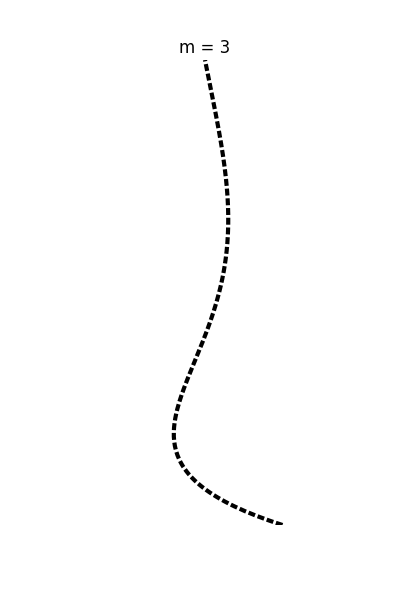The hanging chain
Posted on 26 February 2018
The description of the oscillations of a hanging chain was a problem in mechanics solved by Daniel Bernoulli in the 18th century and which led to the discovery of the class of functions known as Bessel functions.

The code for this article is hosted on github. It can also be run on nbviewer.
The chain is taken to be a narrow, continuous body of length $L$ with linear mass density $\mu$, suspended from a fixed point. Take the origin to be at the free end of the chain in its equilibrium configuration (hanging vertically downwards!), and the $z$ axis to point up; displacements occur in the $xz$ plane (the chain is attached at $(0,L)$) and assume that displacements from the equilibrium configuration are small so that we do not need to distinguish between distances measured along the chain and distances measured along $z$.
With such small displacements, the tension in the chain acts mainly in the vertical direction: $T(z) = \mu g z$. Any net transverse force on an infinitessimal mass element bent through an angle $\alpha$ is due to the difference in the $x$ components of the tension above and below it, $$ \mathrm{d}T_x = \mathrm{d}(\mu g z \sin\alpha) \approx \mathrm{d}(\mu g z \tan\alpha) = \mathrm{d}\left(\mu g z \frac{\mathrm{d}x}{\mathrm{d}z}\right). $$
By Newton's second law, this net force accelerates the mass element: $\mathrm{d}T_x = \mathrm{d}m \frac{\mathrm{d}^2x}{\mathrm{d}t^2}$. Therefore (changing to partial derivatives in recognition of the fact that $x$ depends on time, $t$, and vertical coordinate $z$,
$$ \frac{\mathrm{d}m}{\mathrm{d}z} \frac{\partial^2x}{\partial t^2} = \frac{\partial}{\partial z}\left(\mu g z \frac{\partial x}{\partial z}\right). $$
But $\mathrm{d}m/\mathrm{d}z = \mu$, and so the equation governing the chain's motion becomes
$$ \frac{\partial^2x}{\partial t^2} = g\frac{\partial}{\partial z}\left(z \frac{\partial x}{\partial z}\right). $$
We try a separable solution, $x(z,t) = F(z)G(t)$:
$$ F\frac{\mathrm{d}^2G}{\mathrm{d} t^2} = gG\frac{\mathrm{d}}{\mathrm{d} z}\left(z \frac{\mathrm{d} F}{\mathrm{d} z}\right) = gG\left[ z \frac{\mathrm{d}^2F}{\mathrm{d}z^2} + \frac{\mathrm{d} F}{\mathrm{d} z} \right]. $$ Hence, $$ \frac{1}{G}\frac{\mathrm{d}^2G}{\mathrm{d} t^2} = \frac{g}{F}\left[ z \frac{\mathrm{d}^2F}{\mathrm{d} z^2} + \frac{\mathrm{d} F}{\mathrm{d} z} \right] = -\omega^2, $$ where each equation in $G$ and $F$ must be equal to the same constant, which we call $-\omega^2$. The equation for $G$ is simply that of simple harmonic motion and we may take $G(t) = \cos(\omega t + \phi)$ and set $\phi=0$ since the maximum displacement of the chain will occur at $t=0$. The equation for $F$ can be transformed by the substitution $u^2 = 4z/g$ into $$ u^2\frac{\mathrm{d}^2F}{\mathrm{d}u^2} + u\frac{\mathrm{d}F}{\mathrm{d}u} + u^2\omega^2F = 0, $$ which is one form of Bessel's differential equation of zeroth order. Its solution is $$ F(u) = AJ_0(\omega u), $$ where $J_0$ is the zeroth order Bessel function of the first kind and $A$ is the maximum amplitude of the oscillation.
The full solution to the motion of the chain is therefore $$ x(z,t) = AJ_0\left(2\omega\sqrt{\frac{z}{g}}\right)\cos\omega t. $$ The fixed top of the chain adds the constraint $x(L,t) = 0$ and so the possible values of $\omega$ are determined by the zeros of the Bessel function: $J_0(2\omega\sqrt{L/g}) = 0$: these allowed values are the modes.